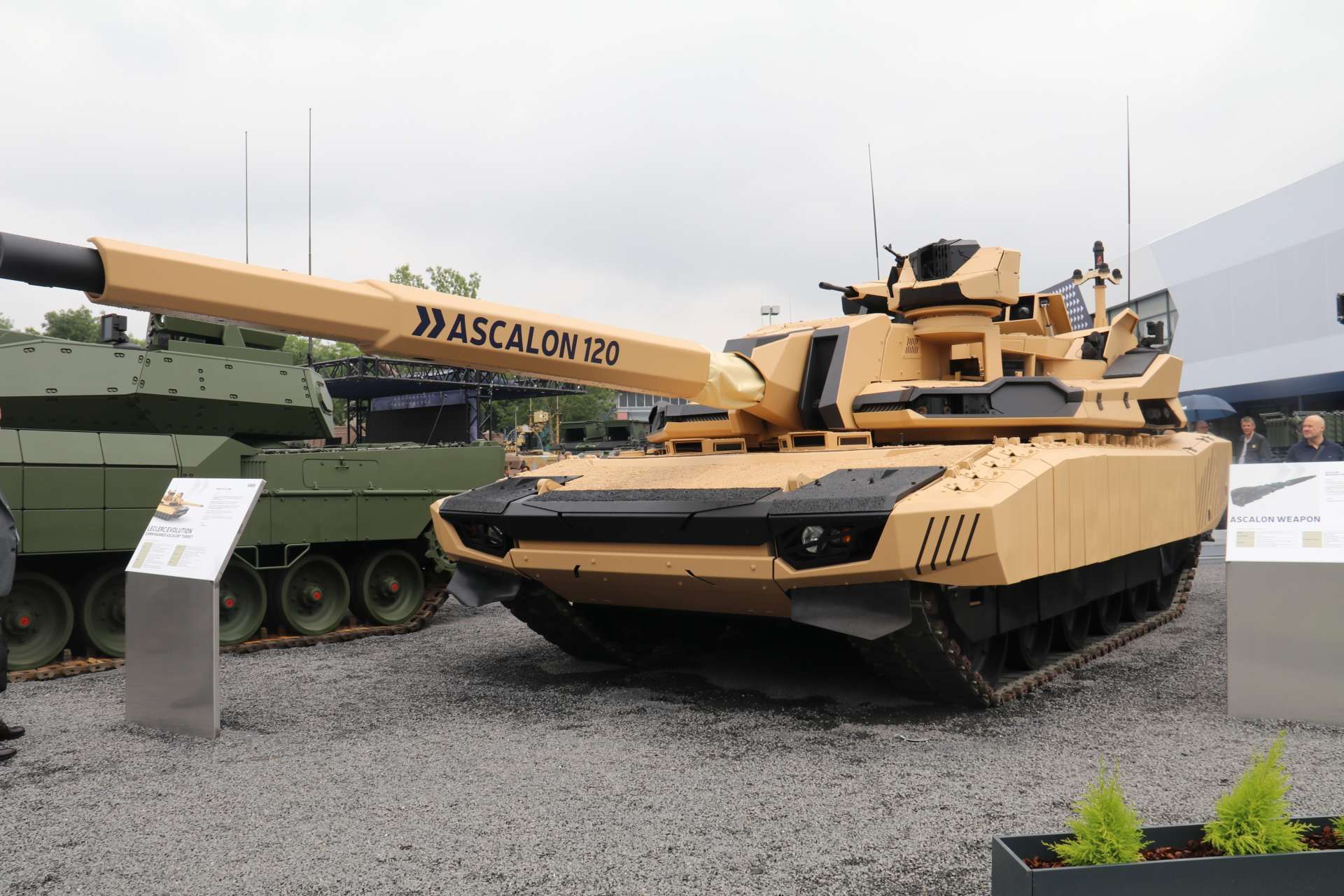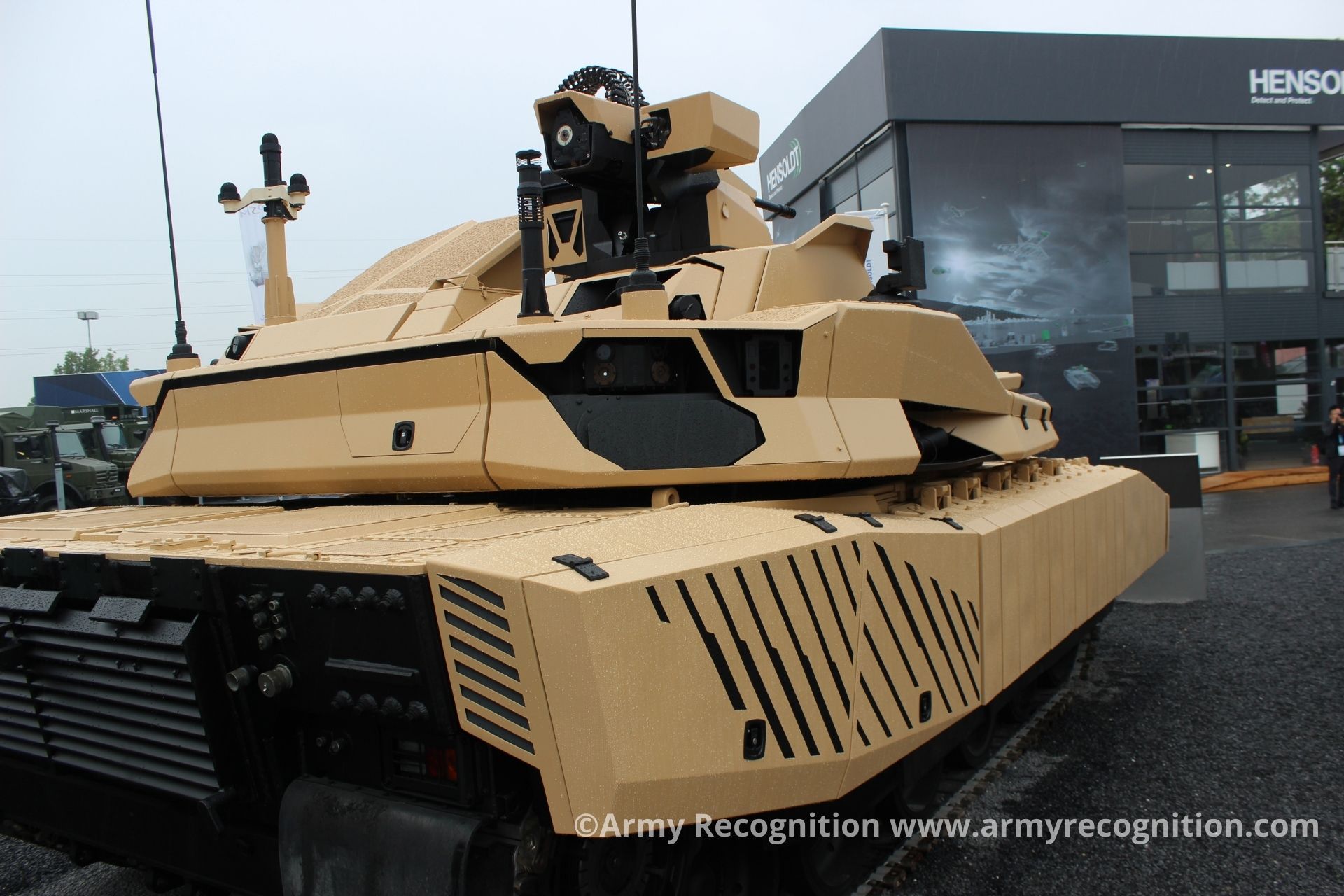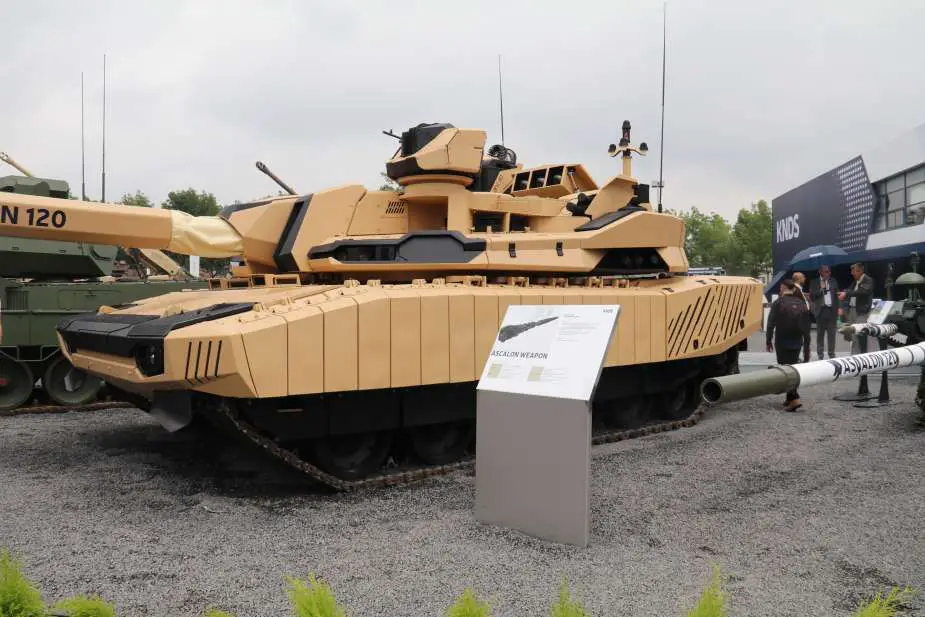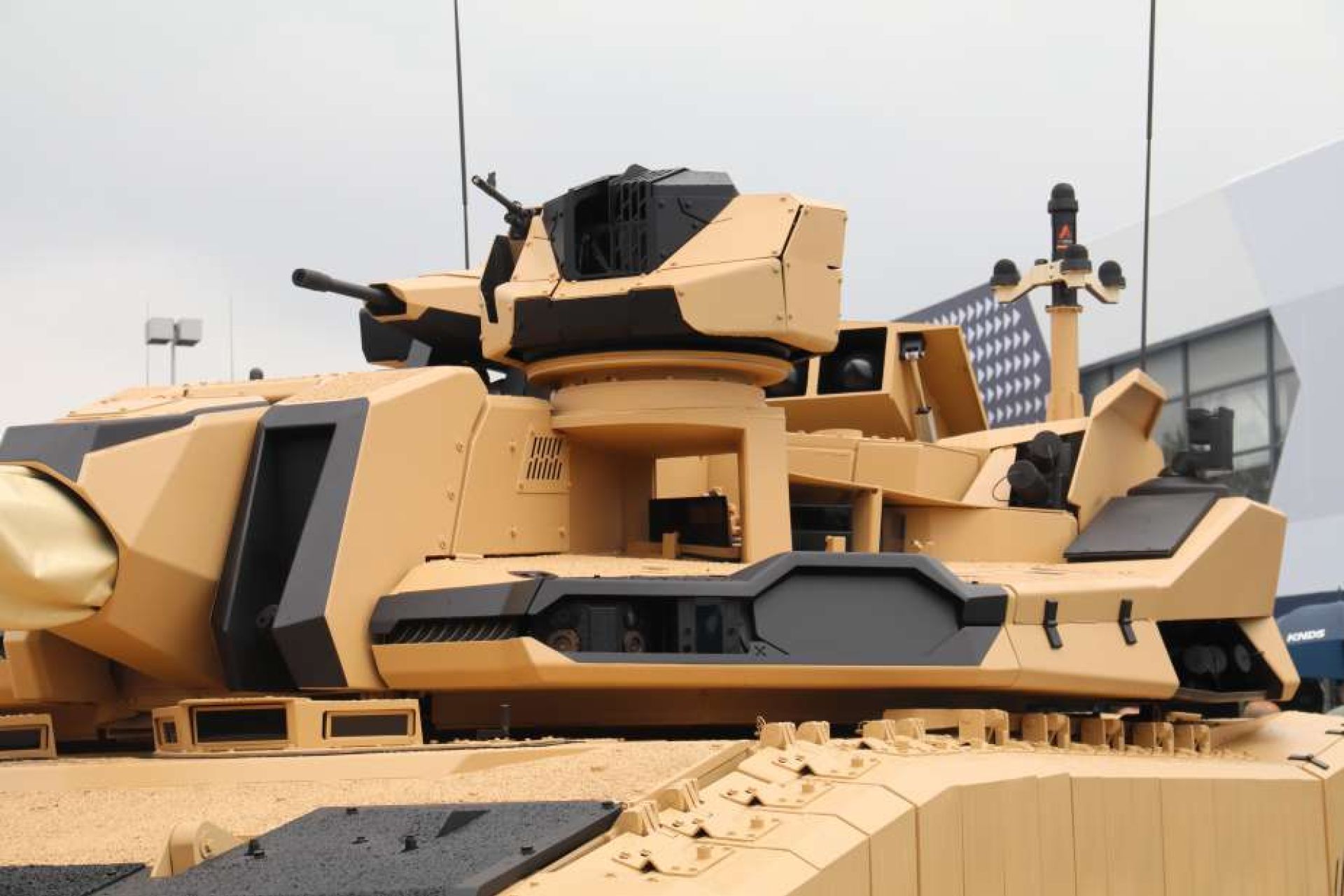Breaking News
Future of Main Battle Tanks: Episode 2 at Eurosatory - KNDS Unveils New Generation Leclerc Evolution MBT.
This is the second episode study of main battle tanks at Eurosatory 2024: the French-German defense conglomerate KNDS has taken center stage with the unveiling of their groundbreaking sixth-generation main battle tank (MBT), the Leclerc Evolution. This marks the debut of the first tank equipped with the new ASCALON 120 mm cannon, a cutting-edge weapon system designed to deliver unparalleled firepower and precision. This announcement follows the introduction of Germany's Rheinmetall KF-51 Panther CUT with its formidable 130 mm cannon, marking another milestone in the evolving landscape of MBTs.
Follow Army Recognition on Google News at this link

Front view of Leclerc Evolution MBT (Picture source: Army Recognition)
The Leclerc Evolution, developed by the French-German defense company KNDS, represents a significant advancement in the realm of main battle tanks (MBTs). This sixth-generation MBT unveiled at Eurosatory 2024, is designed to address the evolving challenges of modern warfare through innovative technology and enhanced operational capabilities. At the heart of the Leclerc Evolution’s offensive capabilities is the ASCALON 120 mm cannon, a next-generation weapon system engineered for superior firepower and precision. This cannon can be retrofitted to accommodate higher calibers, up to a 140 mm gun, providing a flexible platform capable of adapting to future advancements in ammunition technology. The ASCALON cannon ensures that the Leclerc Evolution can engage a wide range of targets with unprecedented lethality, from heavily armored vehicles to fortified positions.
The Leclerc Evolution features a four-crew configuration, with a unique design with two soldiers in the chassis and two in the turret. The turret is equipped with an extensive suite of sensors and effectors, enhancing situational awareness and battlefield management. Including the ARX 30 Remote-Controlled Weapon Station (RCWS) further augments the tank's versatility, enabling it to counter emerging threats such as unmanned aerial vehicles (UAVs) with precision.
A standout feature of the Leclerc Evolution is its ARX 30 secondary weapon, specifically designed for counter-UAV (Unmanned Aerial Vehicle) warfare. In an era where UAVs are becoming increasingly prevalent on the battlefield, this capability ensures that the Leclerc Evolution can effectively neutralize aerial threats, thereby safeguarding its operational integrity. Additionally, the turret is equipped with a loitering ammunition launcher module, which significantly extends the tank’s engagement range and allows for precision strikes on distant targets.

Escamotable loitering munition launch platform (Picture source: Army Recognition)
The loitering ammunition launcher integrated into the Leclerc Evolution’s turret is a game-changer in modern armored combat. This system allows the tank to deploy munitions that can loiter in the airspace, providing real-time reconnaissance and precision strike capabilities. This extended range not only enhances the tank's offensive reach but also provides tactical flexibility, enabling it to support a broader range of missions from reconnaissance to direct engagement.
Currently, the Leclerc Evolution is under development, with KNDS focused on refining its systems and integrating the latest technological advancements. The collaborative efforts between French and German defense sectors underline a commitment to creating a robust and adaptable platform that can meet the future demands of armored warfare.

Rear view of Leclerc evolution turret equipped with UAV jamming system (Picture source: Army Recognition)
The Leclerc Evolution is equipped with a versatile firepower system that includes an ASCALON 120 mm smoothbore gun, which can be upgraded to a 140 mm caliber if needed. The 120 mm gun is of 58 calibers and comes with a 22-round autoloader. Additionally, it has a coaxial 12.7 mm machine gun with 680 rounds ready to fire, and an ARX30 30 mm anti-UAV capability with 150 rounds ready to fire. The tank also includes a loitering ammunition launcher that provides extended range action capability with three intermediate range munitions.
For observation, the Leclerc Evolution is equipped with a commander panoramic sight and a gunner sight, both of which are stabilized for day and night operations, providing a Hunter/Killer capacity. The tank's survivability is enhanced through complete armored protection, regenerative and modular chassis protection systems, a close protection system (Galix smoke and AP), an Active Protection System, and CBRN filtration and air systems.
In terms of mobility, the Leclerc Evolution can reach a road speed of 68 km/h, powered by a 1100 kW (1500 hp) powerpack. It has a range of 470 km on roads and a ground clearance of 475 mm. These features ensure that the Leclerc Evolution is not only a powerful and versatile combat vehicle but also one that offers enhanced protection and operational efficiency on the modern battlefield.

Side view of Leclerc evolution turret equipped with UAV jamming system Loitering munition launch platform (Picture source: Army Recognition)
The introduction of the Leclerc Evolution signifies a strategic shift in how MBTs are conceptualized and deployed. Its advanced firepower, comprehensive command and control systems, and multifaceted defensive capabilities make it a versatile asset in both offensive and defensive operations. The flexibility to retrofit its main cannon to a higher caliber ensures that it remains relevant as new threats and technologies emerge.
Moreover, the integration of counter-UAV systems and extended range loitering munitions reflects a forward-thinking approach to battlefield dynamics, where aerial threats and long-range engagements are increasingly common. The Leclerc Evolution is not just a product of technological advancement but also a response to the changing nature of warfare, where adaptability and multi-role functionality are paramount.
The Leclerc Evolution, with its groundbreaking ASCALON cannon, advanced sensor suites, and innovative defensive measures, represents the pinnacle of modern MBT design. As it progresses through its development phases, it promises to redefine armored warfare by providing a versatile, powerful, and adaptive platform capable of meeting the diverse challenges of future battlefields. KNDS's commitment to innovation and strategic collaboration ensures that the Leclerc Evolution will be a cornerstone of armored forces for years to come.

front view of Leclerc evolution turret equipped with Uav jamming system 7,62 machinegun and 30mm anti UAV system (Picture source: Army Recognition)
The Leclerc Evolution will likely be shunned by the French army.
Tanks are not a priority for the Army today, and for good reason. According to the French army itself, tanks are not currently a priority for them. Indeed, as part of the 2024-2030 Military Programming Law (LPM), it must carry out numerous programs, which will be difficult to fully finance. These include the deployment of the Griffon, Serval, and Jaguar vehicles from the SCORPION program, the design and ordering of the VBAE to replace the VBL, the acquisition of 109 Caesar MkII that must form the backbone of French artillery, as well as the modernization of the Tiger attack helicopters and the introduction of the H-160M Guépard for the Light Aviation of the Army (ALAT).
This forced modernization, a consequence of 25 years of underinvestment in equipment replacement and intensive use of resources in Afghanistan, the Levant, and the Sahel region, leaves virtually no room for the Army's high command to seize opportunities that have arisen during this LPM. Beyond these perfectly clear constraints for the next six years, the Army also suffers from a high command in which light forces, the Legion, marine troops, and paratroopers are overrepresented compared to line units, especially combat tanks.
Thus, over the past 10 years, the army has been commanded by a parachutist (General Bosser), a legionnaire (General Burkhard), and a Marine Infantry officer (General Schill), while the position of Chief of Staff has been held by two parachutists (General de La Chesnais and Gomart), an engineer (General Quevilly), and two cavalrymen (General Barrera and Béchon), who primarily trained in light cavalry.
Given this focus on light and maneuver forces, the imperatives of modernization affecting all equipment, including the pervasive range of medium armored vehicles, recent operational history, and budget constraints, it is hardly surprising that the capabilities of the French line, including combat tanks, heavy artillery, and mechanized infantry, have not been at the center of the Army high command's concerns.


























